In last week’s Hammer of Math, Kevin Genson went through the probability of successfully manifesting psyker powers under various conditions and also discussed the efficacy of the universally known Smite power. This week the psyker shenanigans continue with a discussion of all the “not Smite” powers contained within various disciplines of the Imperium, and Kevin compares the damage output of those powers to Smite itself.
Overview
Nearly every psychic discipline includes at least one and usually several powers which are designed to deal mortal wounds under a variety of conditions. The vast, vast majority of these powers are highly situational and extremely random. Since every Psyker has access to the Smite power, which is guaranteed to deal at least 1d3 mortal wounds to the nearest enemy target if power is successfully manifested, it is possible to compare the damage distribution of smite to these powers and determine which of these, if any, are worth taking and using instead of Smite, and in what circumstances they’ll be useful. Note that, because most tournaments allow psykers to choose their powers at the start of the game (and not during list creation), we’re operating under the assumption that you’ll at least be aware of the army your opponent is playing when determining what psychic powers to take, if not their entire list.
Smite
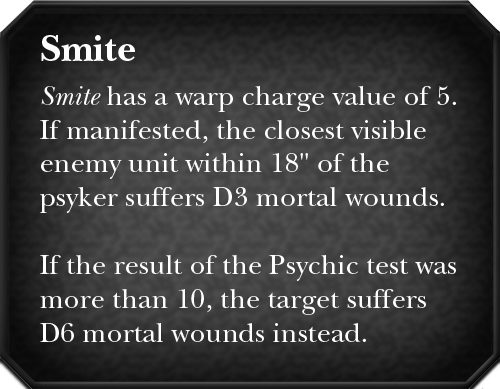
As a review, the Smite power is a universally known ability which will deal either 1d3 or 1d6 mortal wounds to the closest visible target depending on the result of the Psyker test. It can only be target the nearest enemy model, and is currently the only power that can be manifested multiple times each Psychic phase. Every subsequent attempt at manifesting Smite increases the warp charge required to cast by 1 (starting at 5 and capping out at 11), and like all powers each Psyker can only attempt Smite once per turn. Within each discipline are often several powers which have a functionality similar to Smite (dealing mortal wounds), but often the means and probability of dealing those wounds is drastically different. What this article intends to do is provide you with the tools to determine which powers may have a chance of competing with Smite, or at least might be worth using as a second power to deal mortal wounds.

How to Use These Charts
This article contains a series of charts similar to the one below. The colored lines show the probability of dealing a minimum number of wounds to a target for a given power and conditions. The shaded regions represent a comparison; the probability distribution of subsequent castings of the Smite power. To read the chart, look at what shaded region a particular curve fits within. This will tell you whether or not the power being compared is equivalent to the 1st, 2nd, or later casting of the Smite power in terms of mortal wounds dealt.

In the chart above we see a comparison between Storm of the Emperor’s Wrath and Smite. Storm of the Emperor’s Wrath is a power from the Indomitus Discipline that requires the caster to roll 1d6 for each model in the target unit; for every value of 6, the target unit suffers a mortal wound. As a result the efficacy of the power is heavily dependent on the number of targets. In the chart above we can see that the blue line (5 models) and red line (10 models) fall well below the curve associated with the first Smite power. In other words the Smite power has a better chance of dealing more damage than Storm of the Emperor’s Wrath against smaller units. When the target unit has 15 or more models we see the curve break out of the shaded region, indicating it has a higher probability of dealing more wounds than castings of Smite. By using this chart we can make informed decisions about which powers are worth taking depending on the target and situation.
Adeptus Astartes: Librarius Discipline
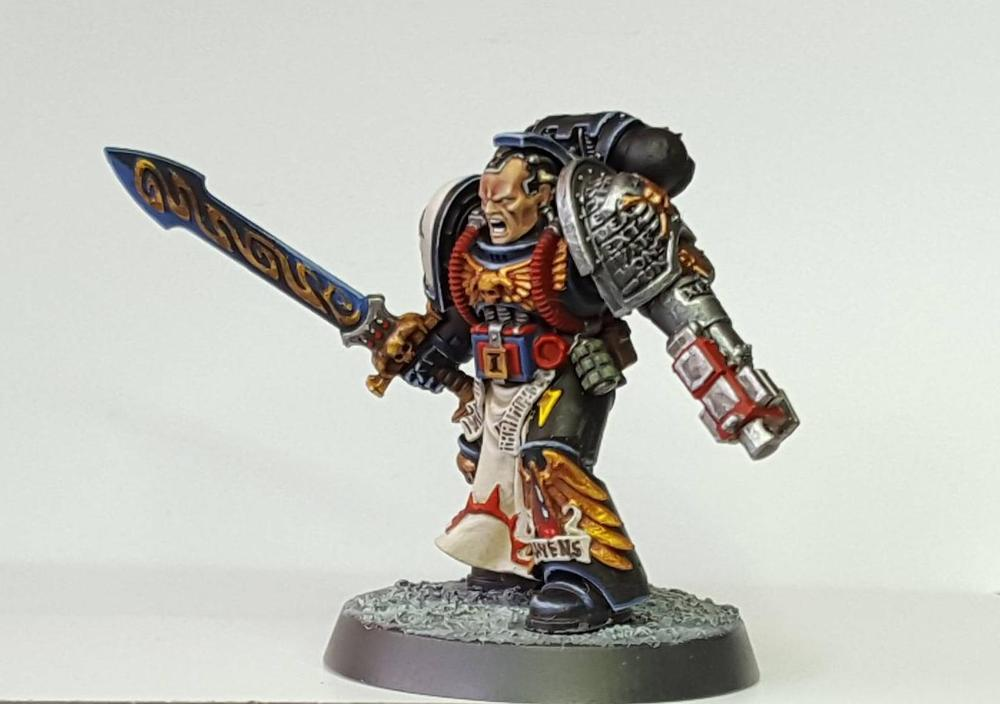
The Librarius discipline has two mortal wound powers: Psychic Scourge (WC 6) and Fury of the Ancients (WC 7). Both powers are more flexible than Smite in the sense that they are not limited to the nearest target (Psychic Scourge can target any visible enemy unit within 18″, Fury of the Ancients is a line attack), but their upside is limited.
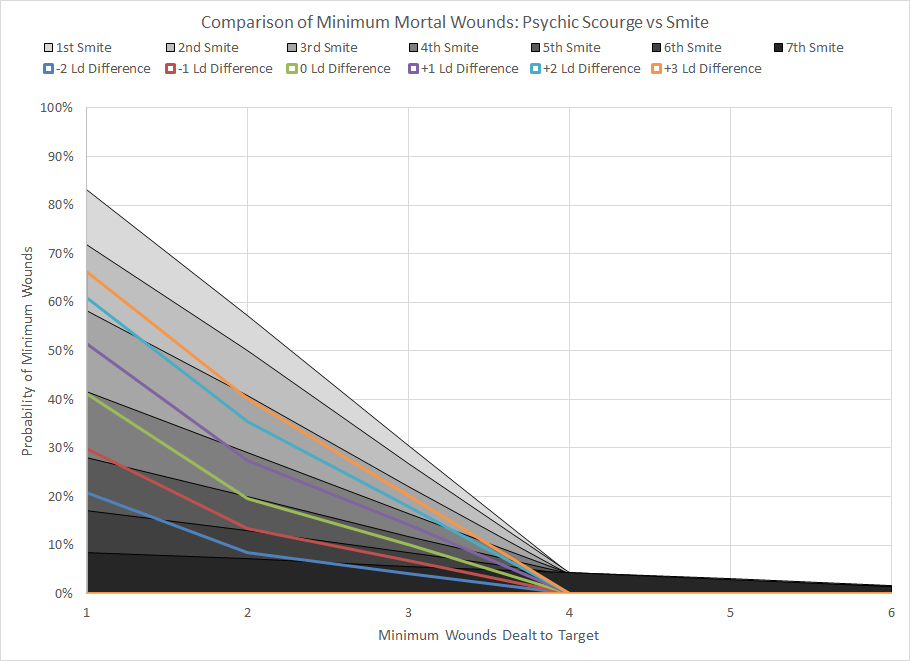
We can immediately see that Psychic Scourge is a fairly mediocre power; even when the caster’s Leadership characteristic is 3 points higher than the target, the power performs worse than the first casting of Smite. This is to be expected as Psychic Scourge has a higher warp charge and is also not limited to the closest enemy unit. Space Marines typically have superior Leadership to other targets, but this power is situational at best.
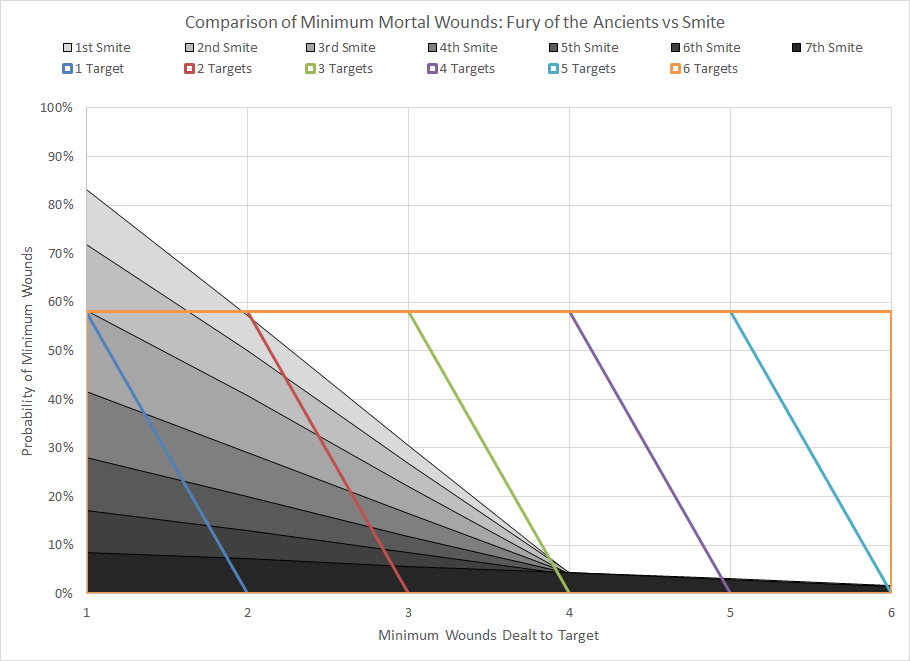
Fury of the Ancients deal a fixed number of mortal wounds that’s exclusively a function of the number of targets between the caster and an enemy model 12″ away. Since the power depends on a simple warp charge 7 Psyker test the probability of success is fixed at 58%, so as expected if three or more targets can be lined up the total damage output is superior to a casting of Smite. The problem is that in general your goal is to concentrate damage onto a high value target; giving one mortal wounds to three targets is typically less useful than dealing three mortal wounds to one target. As a result this power is generally ignored.
Adeptus Astartes: Obscuration Discipline
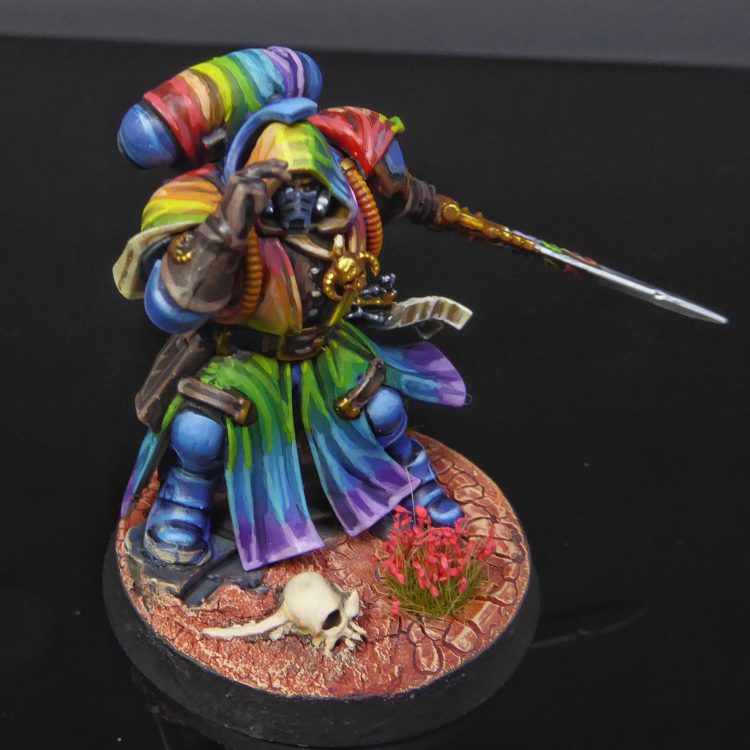
The Obscuration discipline contains two powers that can deal mortal wounds: Mind Raid (WC 6) and Tenebrous Curse (WC 6). In both cases the effect is a single mortal wound with a 72% chance of success. This may be useful for stripping off a final wound from a high value target (both powers only require Line of Sight and have an 18″ range), but in general the power is cast for the secondary effect of obtaining a CP or halving the Movement characteristic of the target. Tenebrous Curse can be combined with the Space Wolf power Jaws of the World Wolf to potentially deal significant damage.
Ultramarines: Indomitus Discipline
The Ultramarines’ special discipline has two powers that deal mortal wounds. Storm of the Emperor’s Wrath (WC 6) is intended for use against hordes as the player rolls 1d6 for every model in the target unit and every roll of a 6 deals a mortal wound; it is limited to the nearest visible enemy unit. Telepathic Assault (WC 7) can target any visible unit within 24″ and deals mortal wounds based on a dice roll – the caster’s controller rolls 2D6+2 and the target suffers mortal wounds equal to the difference between the result and the highest Ld value of a model in the unit.

Since both Storm of the Emperor’s Wrath and Smite target the nearest enemy unit we can make a direct comparison between the two powers. We quickly see that below 15 models Smite is unquestionably a superior power; Storm of the Emperor’s Wrath simply doesn’t provide enough opportunities to reliably deal more mortal wounds. This changes at higher quantities; although the probability of dealing any damage at all is fixed at 72% since the warp charge value is 6, the probability of dealing more wounds makes this is a viable option against horde armies. Ideally this power (and those that are functionally identical in other factions) would be used against units with 15 or more models.

Telepathic Assault is an extremely mediocre power. Not only does the high warp charge mean that the power will succeed only 58% of the time, but you then run the considerable risk of dealing no damage at all if you roll equal to or less than the target’s Leadership. There may be an edge use case against targets with severely reduced Leadership characteristics, but those types of combined effects generally require careful maneuvering or have a low probability of success.
White Scars: Stormspeaking
Within the Stormspeaking discipline White Scars players have access to Lightning Call (WC 7) and Eye of the Storm (WC 6). Lightning Call has identical targeting requirements to Smite but has a change of dealing additional mortal wounds on three rolls of 4+, 5+, and 6+. Eye of the Storm is an area-effect power where the player rolls 1d6 for every enemy unit within 12″; on a 4+ that unit takes 1 MW.
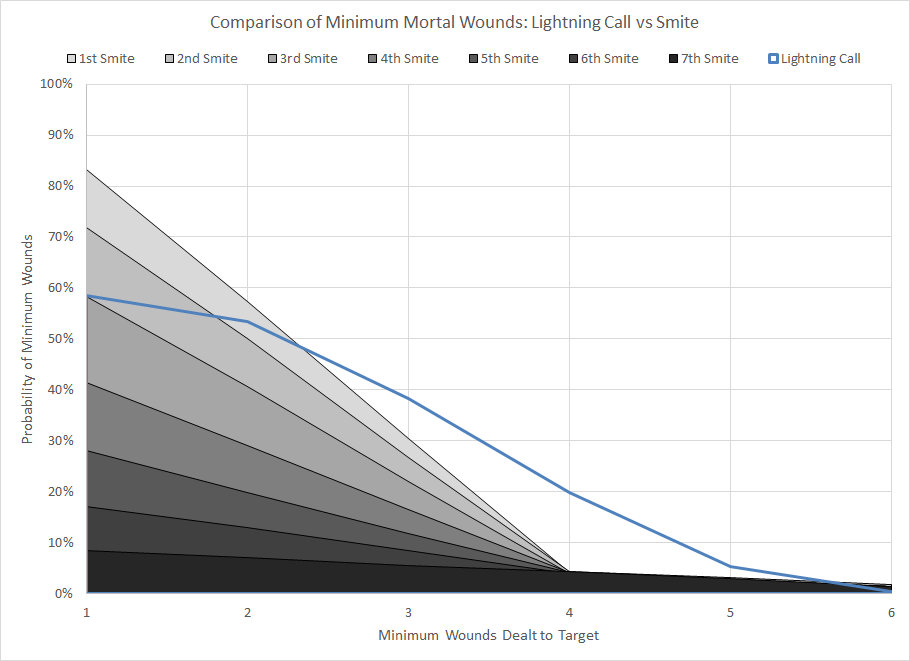
As far as Smite clones go Lightning Call actually isn’t too bad. With a warp charge value of 7 the probability of dealing any damage is only 58%, but the average number of wounds dealt to the target on a successful cast is higher than Smite due to the sequential additional rolls. The expected value of a successfully manifested Lightning Call is 3 mortal wounds.
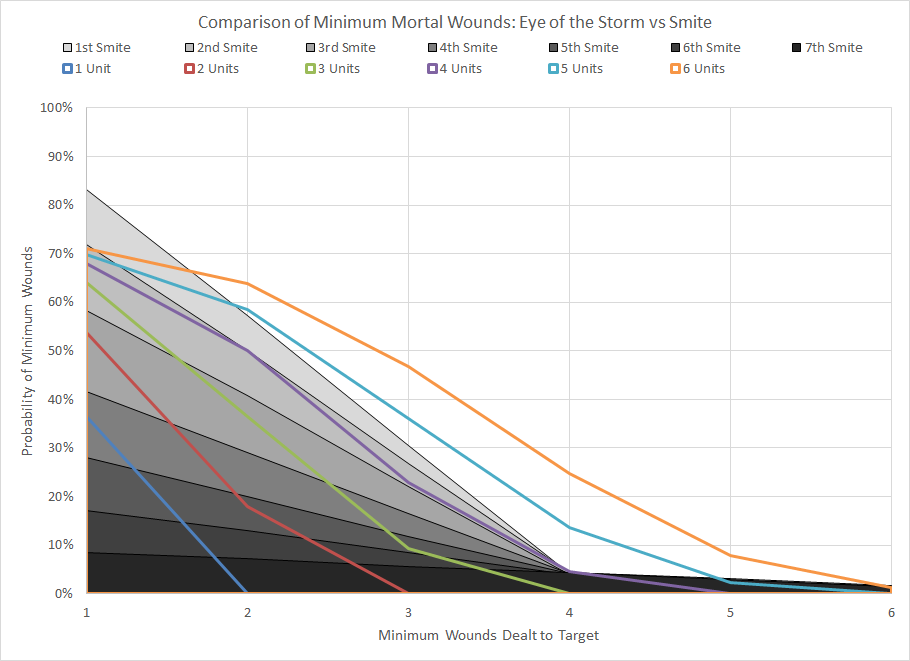
Eye of the Storm suffers from the same problem as other area-effect powers: The efficacy is heavily dependent on the quantity of targets and the distributed nature of the attack reduces the utility when compared to a targeted strike. Although potentially useful against a group of characters, the limited amount of damage makes this power one that is too situational to be really useful.
Iron Hands: Technomancy Discipline
I’ll admit; I’m more than a little disappointed that the Iron Hands psyker powers aren’t under the Ferromancy discipline. They ran the pun into the ground everywhere else, and yet here we are. The Sons of Medusa have access to two powers that deal mortal wounds: Fury of Medusa (WC 6) is a line power with an 18″ length; every unit the line crosses is subject to a d6 roll that can result in 1 mortal wound on a 4 or 5 or d3 mortal wounds on a 6. Against vehicles the roll is improved by +2. Machine Flense (WC 6) can only target a visible enemy vehicle within 18″ but will deal 1d3 mortal wounds to the target and can deal up to an additional 3 wounds to another enemy unit within 6″.
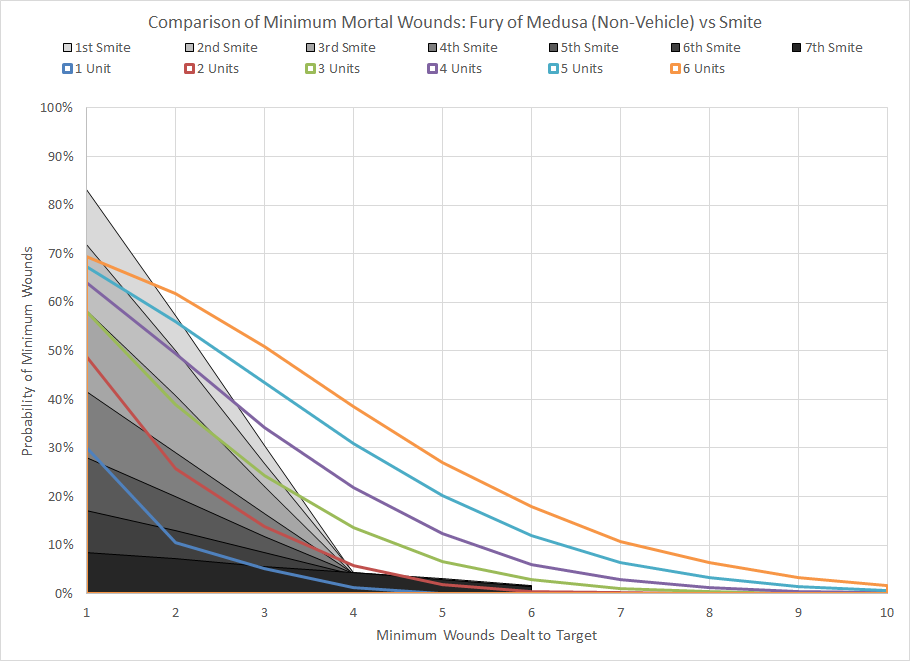
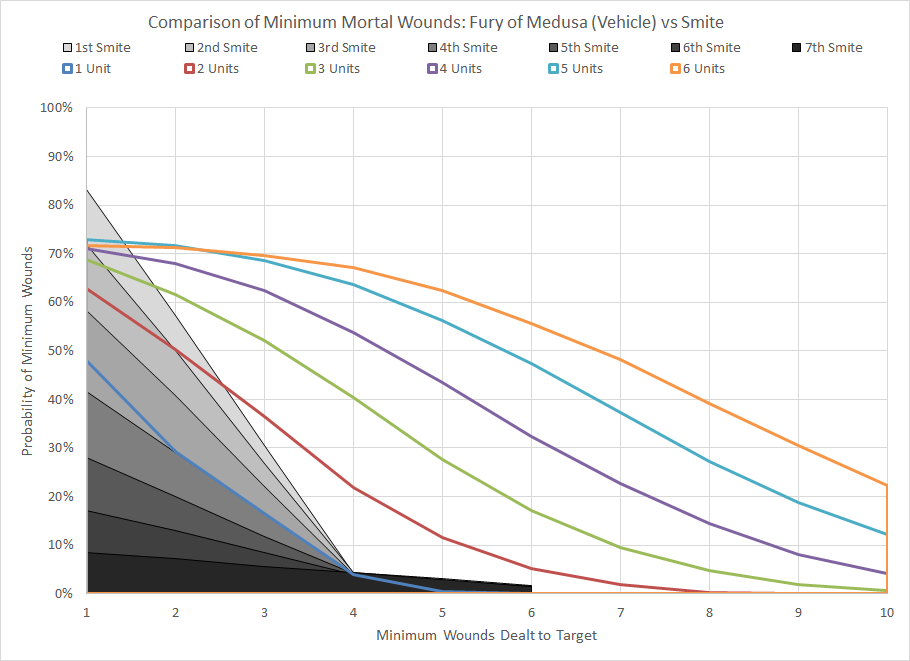
The top chart is for non-vehicle targets while the bottom chart is against vehicles. With a warp charge of only 6 the power has a 72% chance of manifesting, and with an 18″ range chances are good that multiple units can be affected. Against vehicle-heavy forces this power can potentially be the equivalent of multiple simultaneous smites. The challenge will be getting them all together in a line, but even with just two vehicles you will see benefits over a second casting of Smite.
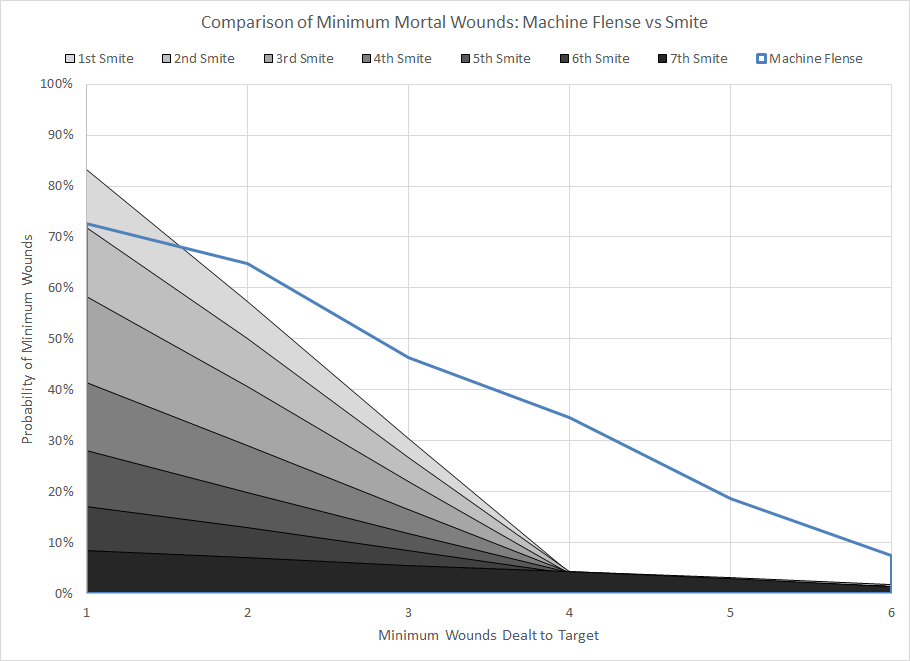
If the enemy force has any vehicles then Machine Flense is one of the rare mortal wound-dealing psychic powers which is actually comparable (if not strictly superior) to Smite. With a 72% chance of dealing damage and a high probability of dealing additional mortal wounds to a nearby target this power could potentially be very useful. Obviously this power is useless against Tyranids or any force that has few or inaccessible vehicles (or that has a bunch of units that should be vehicles, but instead have the BATTLESUIT keyword).
Raven Guard: Umbramancy Discipline
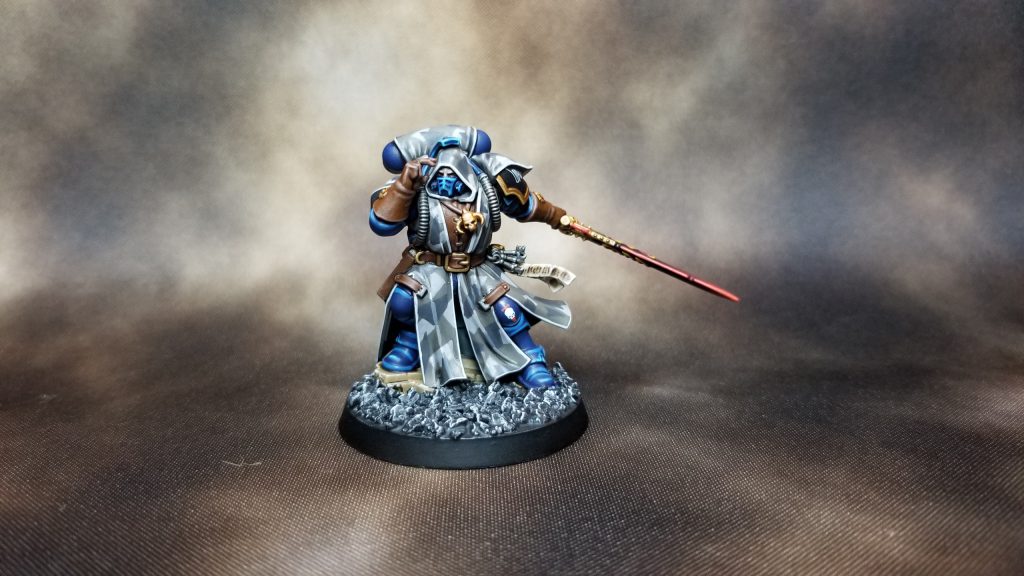
Get it? Umbramancy? Shadow Magic? Because Raven Guard are sneaky. It’s clever. Really.
Raven Guard have two powers that deal mortal wounds. The Abyss (WC 6) is an attack against 1 visible enemy unit; you roll 3d6 and each 4+ deals 1 mortal wound. Killing an enemy model also reduces the unit’s leadership by 1. The Darkness Within (WC 6) attacks three visible enemy units; for each unit you roll 1d6 and on a 4+ (or a 3+ if the Psychic test was 10 or better) you deal 1 mortal wound to the unit. You cannot target the same unit more than once, limiting this power to a maximum of 1 mortal wound per unit (and 3 mortal wounds total).
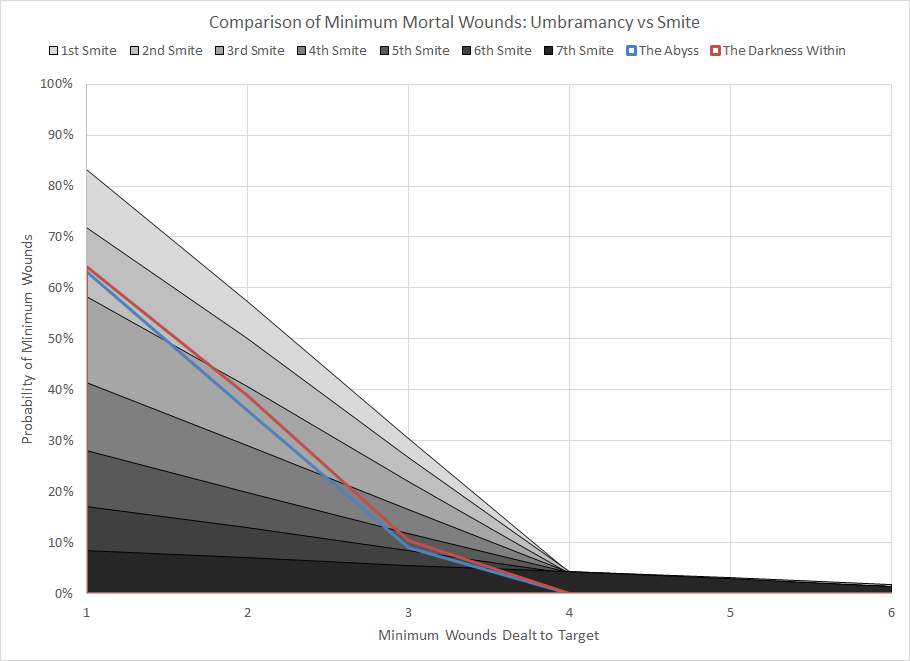
It’s a good thing that the other options in the Umbramancy discipline are solid because these two Smite alternatives are pretty poor. Both powers have a roughly 36% chance of not dealing any damage at all due to the combination of warp charge and randomness associated with each potential mortal wound. The Darkness Within is particularly bad as the mortal wounds must be distributed across multiple targets, eliminating any potential for focused damage on a high-value target.
Salamanders: Promethean Discipline
The Salamanders have some phenomenal protective abilities which provide excellent synergy with many of their Stratagems. On the offensive front there are three powers which deal mortal wounds. Burning Hands (WC 6) allows the Psyker to deal 1 mortal wound in close combat every time he hits. In this case the effect is entirely dependent on the number of attacks and the model’s WS, so without augmentation you’re expecting around two to three mortal wounds per round of combat. The other two powers are ranged abilities which are not limited to the closest target. Flaming Blast (WC 6) will affect every unit within 3″ of a visible point within 24″ of the caster; on a 4+ each unit takes a mortal wound. Fury of Nocturne (WC 6) will deal 1d3 mortal wounds to a target visible unit within 18″ if the player can beat the target unit’s Toughness characteristic on a roll of 2d6.
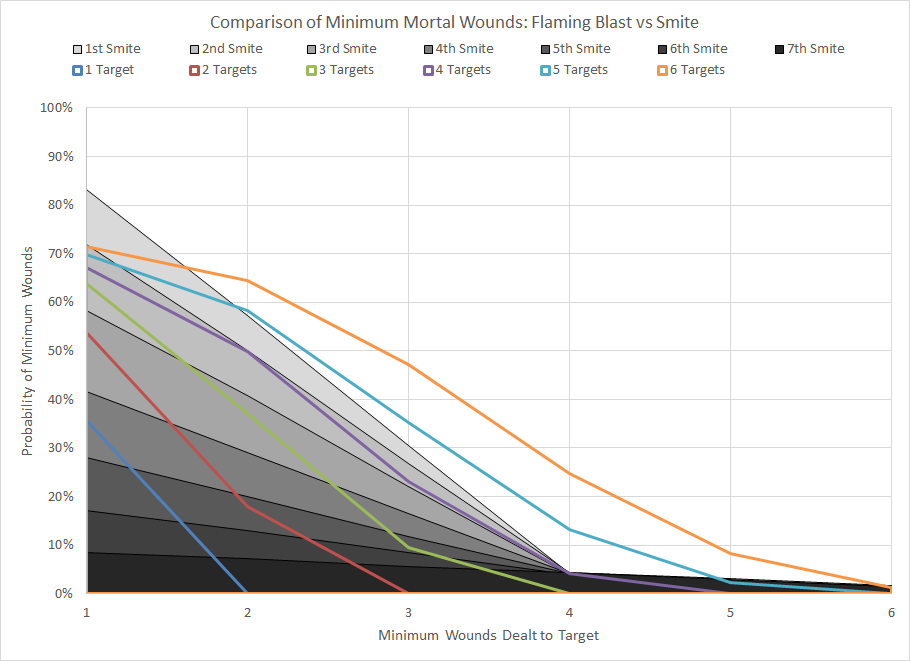
As is the case with most of the area-effect powers, the efficacy of Flaming Blast is directly proportional to the number of targets. There are other, better powers in the Promethean discipline that should be taken over this one.
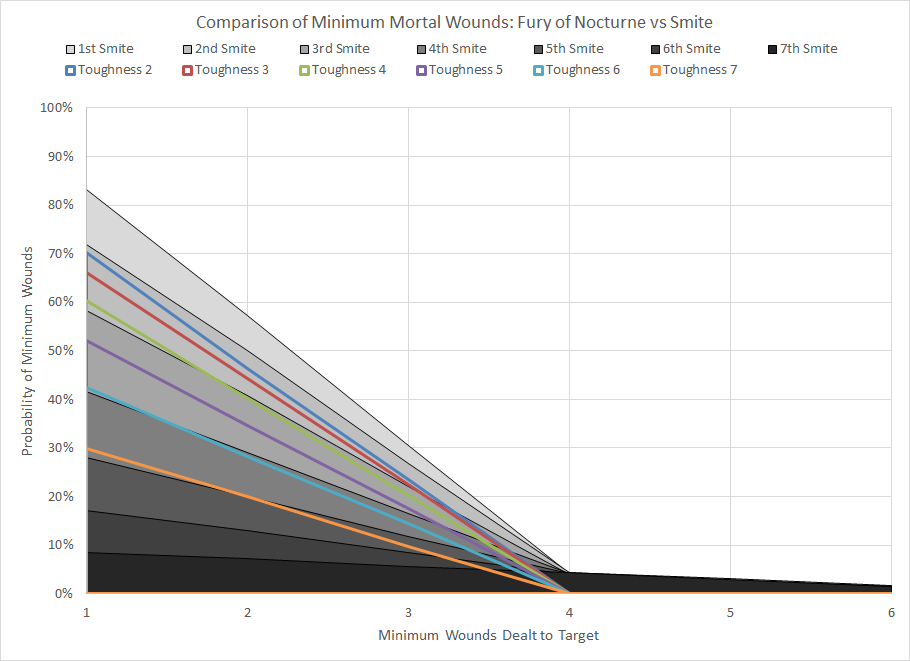
Fury of Nocture is ultimately an incredibly situational power which is insufficiently deadly for the level of unpredictability that the power contains. You’re better off avoiding this one.
Imperial Fists: Geokinesis Discipline
One half of the Geokinesis discipline is dedicated to offensive powers designed to inflict mortal wounds. Wrack and Ruin (WC 6) requires a target that is within 18″ and is either a building or wholly within or on a terrain feature; if manifested the player rolls nine dice and every 5+ (4+ if the target is a building) will deal 1 mortal wound. Iron Inferno (WC 6) is an area power; the player chooses a point within 18″ and visible to the psyker and rolls a die for every unit within 6″. Every result of a 4+ deals 1 mortal wound. The results are identical to Flaming Blast from the Salamander’s Promethean discipline and you can find the results there; because the area of effect is 6″ in diameter and not 3″ like Flaming Blast the power may be worth taking if you have a slot. Chasm (WC 6) is interesting because, like Smite, it is guaranteed to do damage to a visible target within 18″ and cannot fly. If manifested the player rolls 2d6. If the result is less than the lowest Movement characteristic the power deal 1 mortal wound. If the result is equal then the power deals 1d3 mortal wounds, and if the result is greater the unit takes 3 mortal wounds. This power offers some synergy with Tenebrous Curse from the Obscuration disicpline.
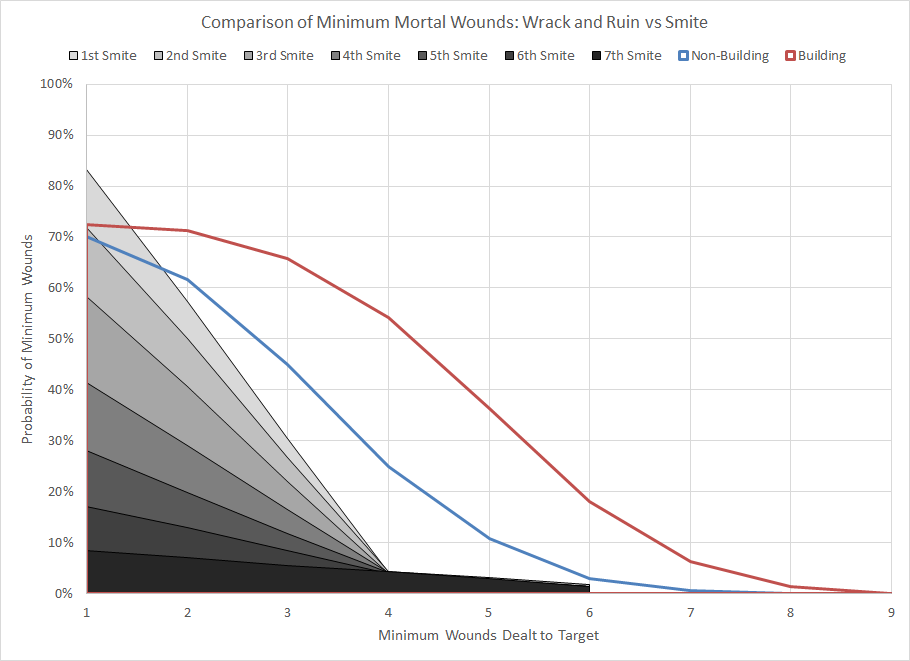
You can basically ignore the red line as buildings are extraordinarily rare, but in any scenario where it’s reasonable to expect targets in terrain Wrack and Ruin is superior to Smite. This is an example of how situational powers should be in Warhammer 40K. Instead of burdensome requirements that result in a terrible outcome, you have a situational power with a significant chance of doing a large amount of damage. This power also has the advantage of forcing your opponent to reconsider his deployment and placement strategy, and balance the risk of mortal wounds with the benefits of cover. For actual Imperial Fists (who ignore cover) this calculation vastly favors avoiding terrain and the power may not be as relevant.
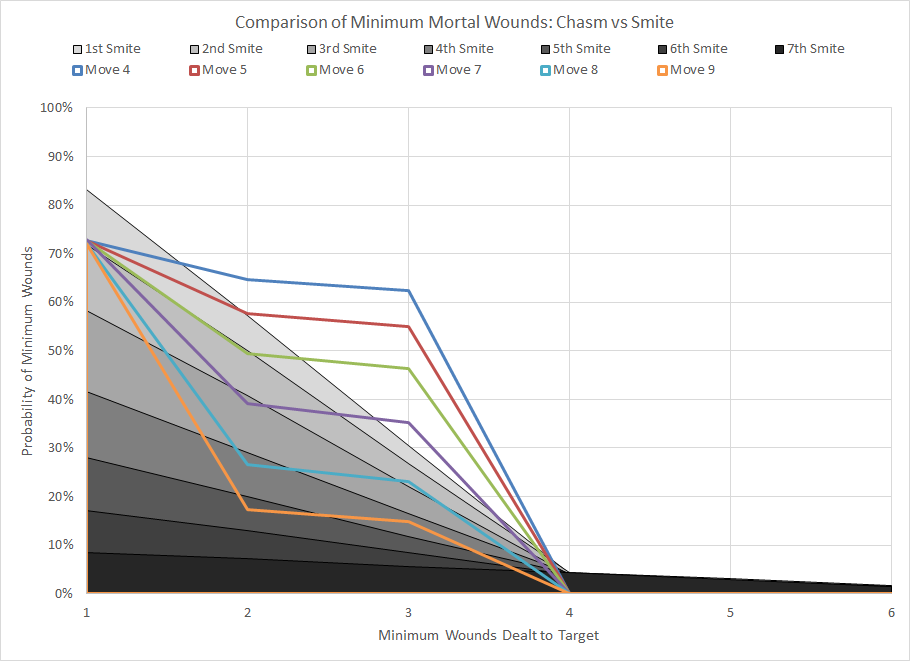
Another surprisingly powerful ability which can do significant damage to targets with low movement. Anything that has a Move characteristic of 6 or less is likely going to get at least two mortal wounds, and unlike many Smite-like powers Chasm is guaranteed to deal at least one mortal wound to the target. Combined with the one mortal wound dealt for a successful manifestation of Tenebrous Curse, you can reliably expect to deal 4 mortal wounds to a visible target.
Dark Angels: Interromancy Discipline
I suppose this is a clever way of saying interrogation magic.
Although the Dark Angels have some extremely good powers in the form of Mind Wipe (which can permanently degrade an opponent’s characteristics) and Aversion (72% chance to force a -1 hit penalty on an enemy unit within 24″), they also have an unquestionably worse version of the Ultramarine’s Telepathic Assault power in the form of Trephination (WC 7). Trephination has the same warp charge value as Telepathic Assault, but a reduced range, and can only be used against the closest visible enemy unit. On top of that Trephination has the same effect as Telepathic Assault (2d6 test versus Leadership to deal 1 mortal wound for every point over) but only gets a +2 bonus on a Psychic test result of 11 or 12.
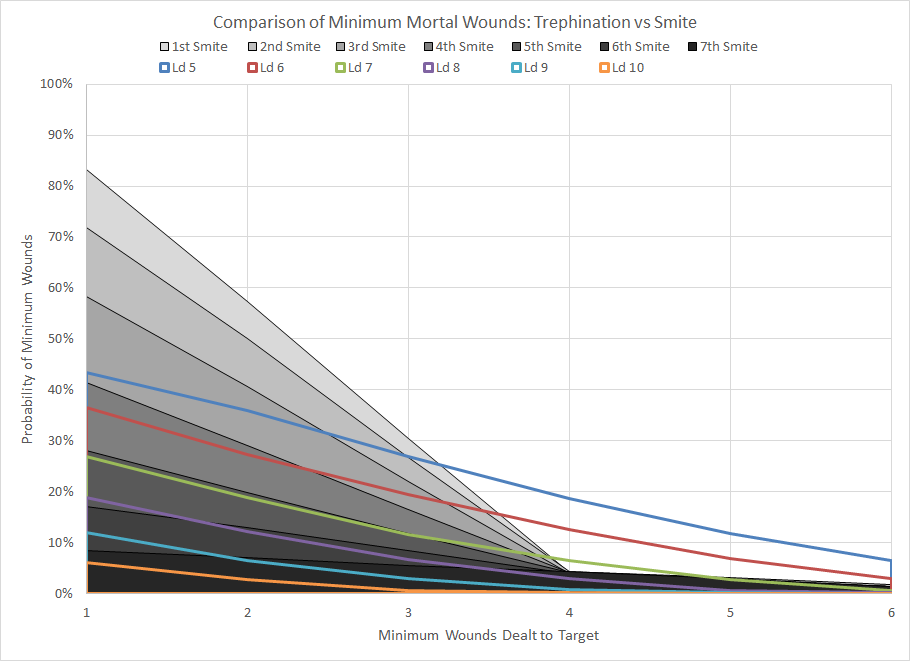
I’ll let our resident Dark Angel expert Greg “Greg” Chiasson provide his thoughts…
Jesus. I knew it was bad but even best case it has like almost a 60% chance of doing fuck all. Also I’m not surprised the Hands version is so much better. Of course it would be. Why wouldn’t they get better powers, they already have better everything else.Just fucking trephinate me irl.
Blood Angels: Sanguinary Discipline
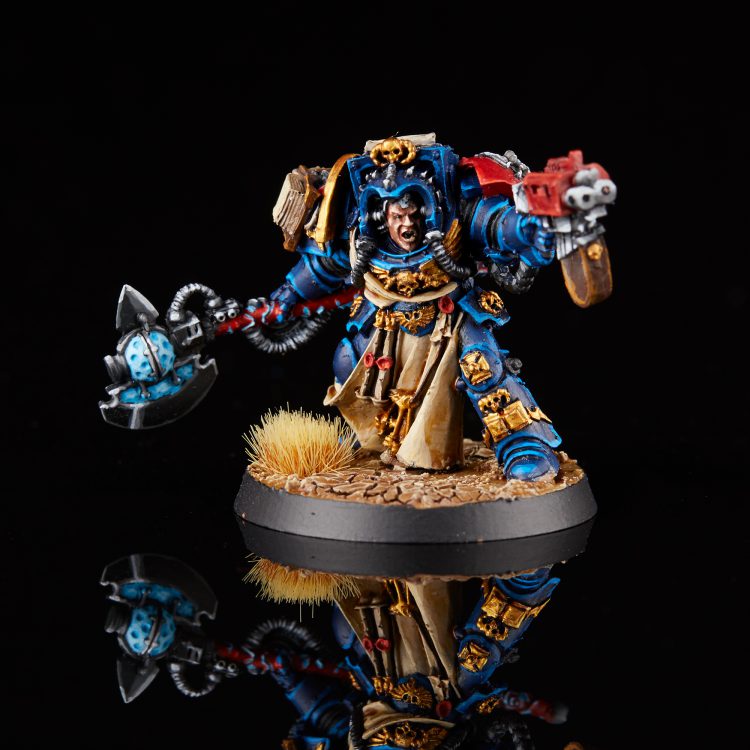
The Blood Angels have two powers which deal mortal wounds. Blood Boil (WC 6) is a focused attack against a target within 6″. If the target’s toughness is exceeded on 2d6 then the target suffers 1d3 mortal wounds. If the result is more than double the target’s toughness than the result is a flat 3 mortal wounds. The Blood Lance (WC 6) is a line attack with a 12″ range; for every model (not unit) that the line passes over a mortal wound is dealt to that model’s unit on a d6 roll of 5+. Neither of these powers is particularly good.

Blood Boil is not worth taking. Against any target with a Toughness characteristic greater than 3 you’re better off using Smite, and with a cast range of 6″ you’re probably better off charging the T3 target anyway.
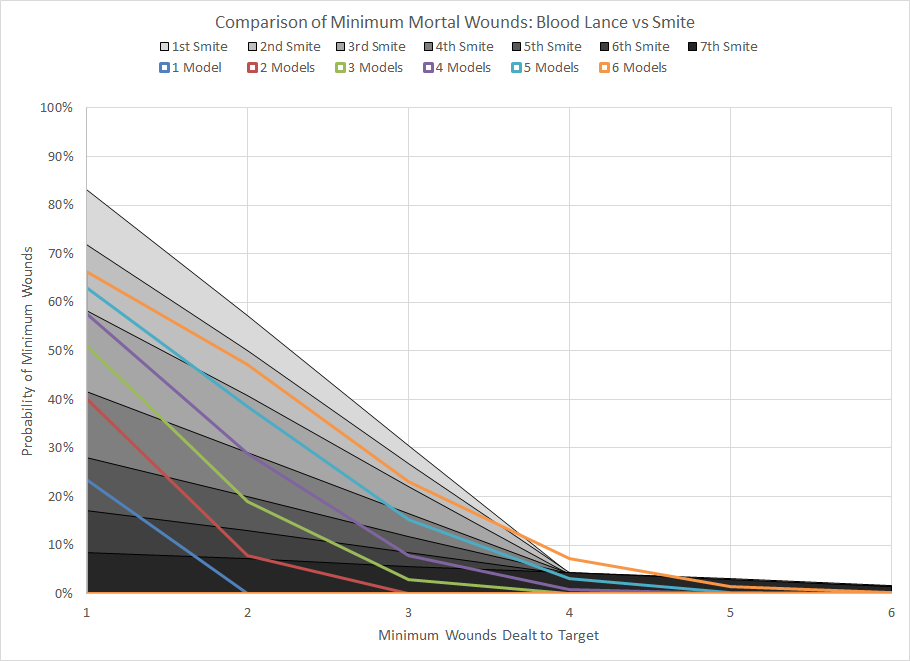
Blood Lance is a power that could potentially be useful against large concentrations of enemy models, but even if you manage to get 6 models in a line the first casting of Smite has a higher probability of success. This is another power to avoid.
Space Wolves: Tempestas Discipline
Space Wolves have three powers which can deal mortal wounds. Living Lightning (WC 6) is a Smite clone which does d3 mortal wounds to the nearest visible enemy unit and, if that unit dies, will deal another 1d3 mortal wounds to the closest enemy unit within 18″ of the last model removed. This effect continues until something lives or there’s nothing in range. Space Wolf Rune Priests can super charge this ability by using the Living Storm Stratagem to up the damage to 1d6 for 1CP, but this requires three Space Wolf Librarians to be in close proximity to one another. Murderous Hurricane (WC 5) is an excellently named anti-horde power where the player rolls 1d6 for every model in the target unit and deals 1 mortal wound for every 6. Jaws of the World Wolf (WC 7) is a power that can target any non-VEHICLE unit within 18″ (it does not require Line of Sight). If manifested the player rolls 2d6; for every point that this result exceeds the target’s Movement characteristic by the target takes 1 mortal wound.

By itself Living Lightning is comparable to the second casting of Smite, although the chart above does not include the bonus mortal wounds associated with killing the first target. When the mortal wounds dealt is increased to 1d6 via the Living Storm Stratagem the power becomes significantly more effective, although the circumstances required to do this (three Librarians and 1 CP) make it a costly endeavor.
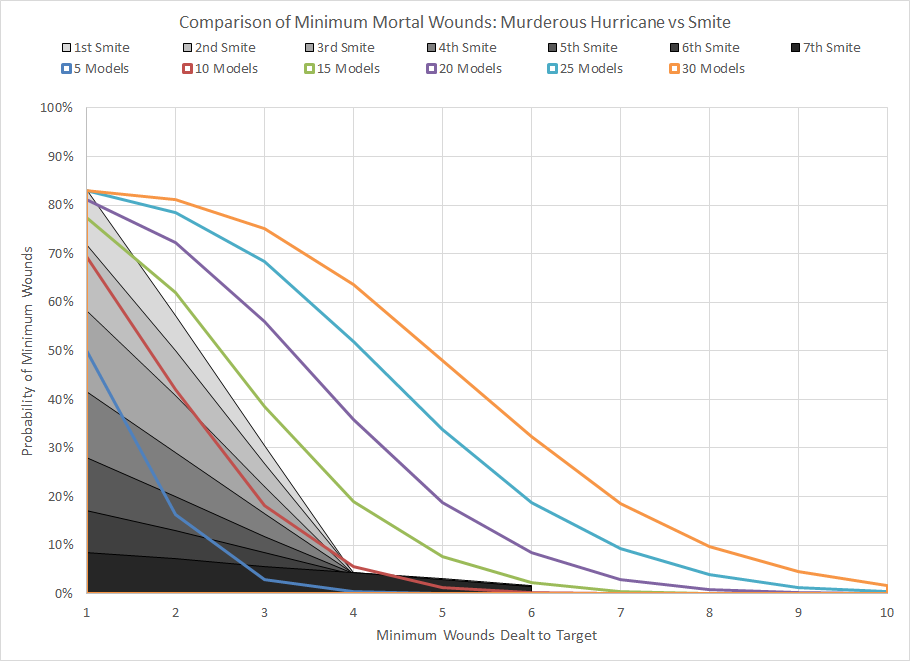
With a warp charge value of only 5 Murderous Hurricane is arguably the best of the mob-targeting powers, but it is still a situational power that requires at least 10 to 15 models in the target unit to be a better option than Smite.
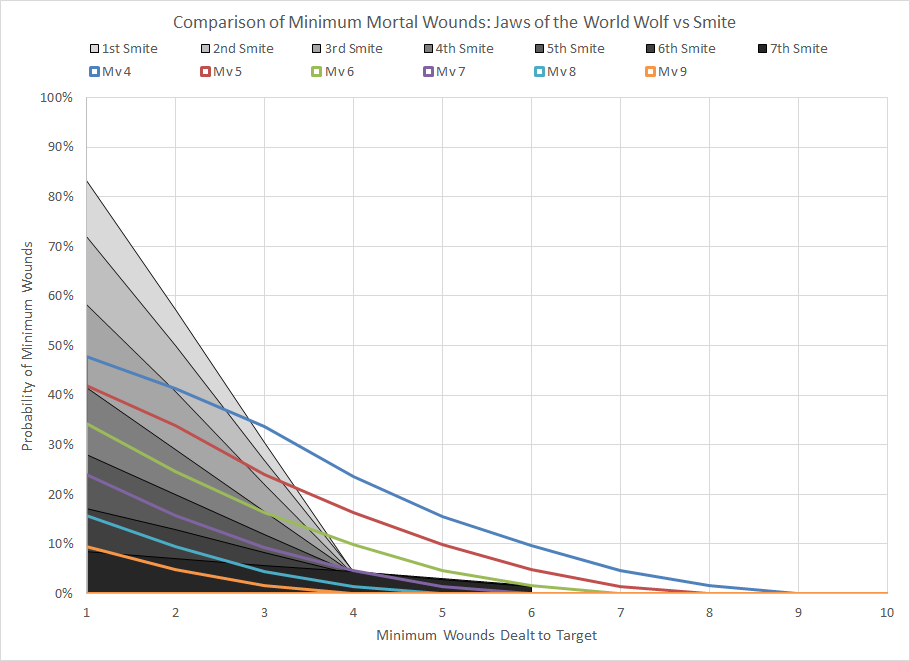
With a warp charge of 7 Jaws of the World Wolf only has a 58% chance of manifesting without a Command re-roll. If it does manifest, the probability of doing any damage degrades significantly as the Movement characteristic of the target increases. Even against slower targets the probability of doing any damage at all is less than 50%. In a vacuum the power is not very good, but perhaps when combined with Tenebrous Curse it could become more effective.
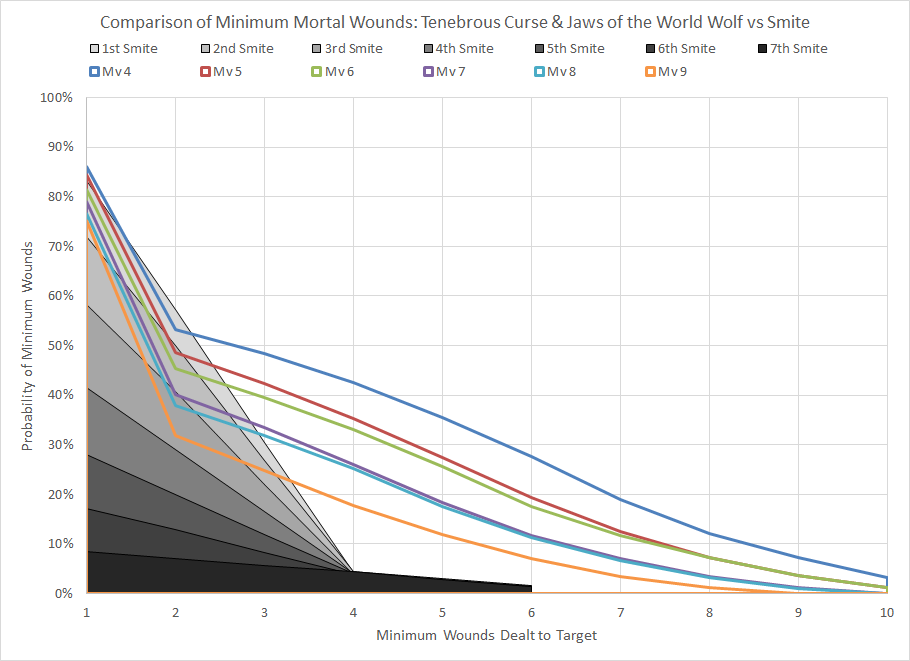
This particular combination does indeed improve the probability of dealing damage to the target, outperforming Smite (although it does require two Psykers to perform). That said, a roughly 35% chance to deal 4 mortal wounds to a target with a Move characteristic of 5 or 6 is certainly notable. This could be further improved by getting a bonus to cast Jaws of the World Wolf through the use of Njal Stormcaller or the Empyric Channeling Stratagem.
Grey Knights: Sanctus Discipline
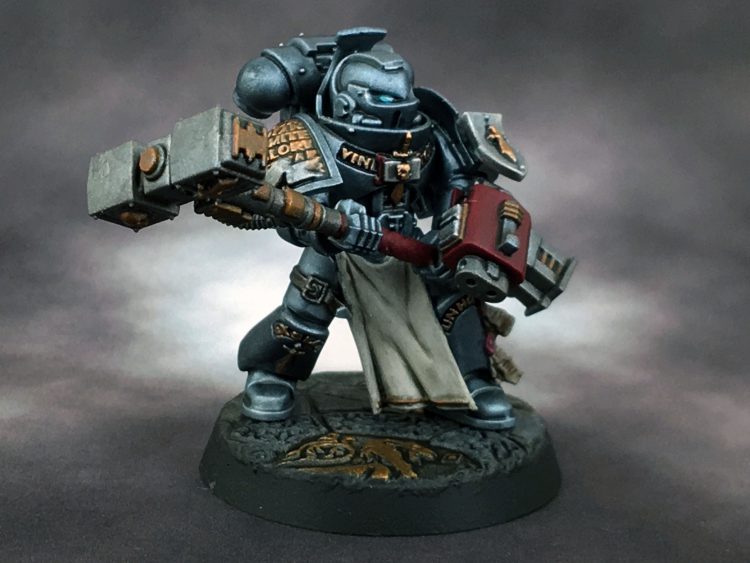
Grey Knights have access to two short-ranged mortal wound powers. Purge Soul (WC 5) has a 12″ range and, if manifested, forces a roll-off where the player and opponent roll 1d6 and add their respective Leadership characteristics. If the Grey Knights player wins the target takes mortal wounds equal to the difference between the results. Vortex of Doom (WC 8) also has a 12″ range and deals 1d3 mortal wounds to a target model’s unit as well as 1d3 mortal wounds to every unit within 3″ of that model. If the result of the power is 12 or greater the damage becomes 1d6.
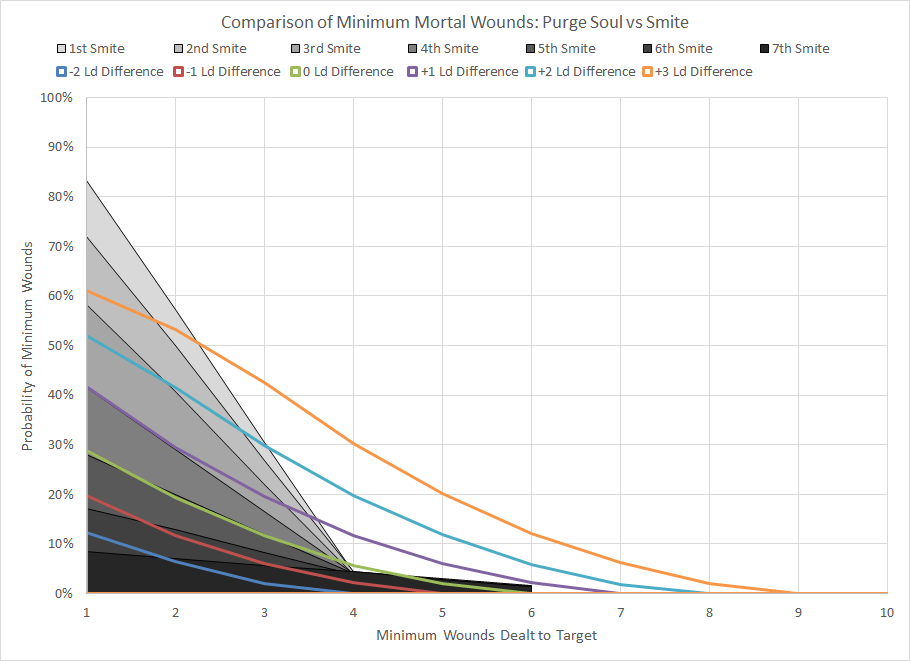
Given the presence of so many Space Marines and other high Leadership armies it is unlikely that the Grey Knights player would see anything but a minor bonus to a contested roll. Between the high probability of failure and short range this power is just yet another example of how bad the Grey Knights codex is.
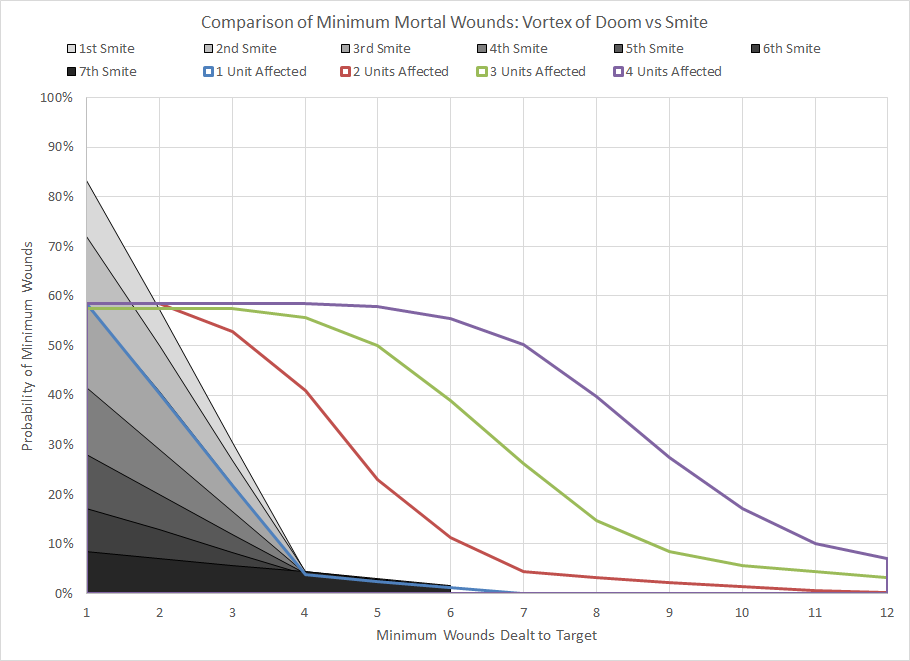
If only one target is affected then Vortex of Doom is equivalent to casting Smite a third time at a reduced range. Against opponents who have multiple units clumped together (such as a dense castle of vehicles surrounding an Ironstone bearer) then there is a significant potential for damage as you effectively cast Smite on each target. It may be worth considering the use of a Grey Knight Psyker in an auxiliary support detachment, as he can potentially teleport in and have his power bolstered by the Psychic Channeling Stratagem (1 CP to roll 3d6 and pick the two highest) to have a high chance of success. At the very least it would force your opponent to alter his deployment and placement strategy in order to minimize the number of units close to each other. This could be accomplished for as little as 80 points with Castellan Crowe or 66 points with a Techmarine.
Astra Telepathica: Psykana Discipline
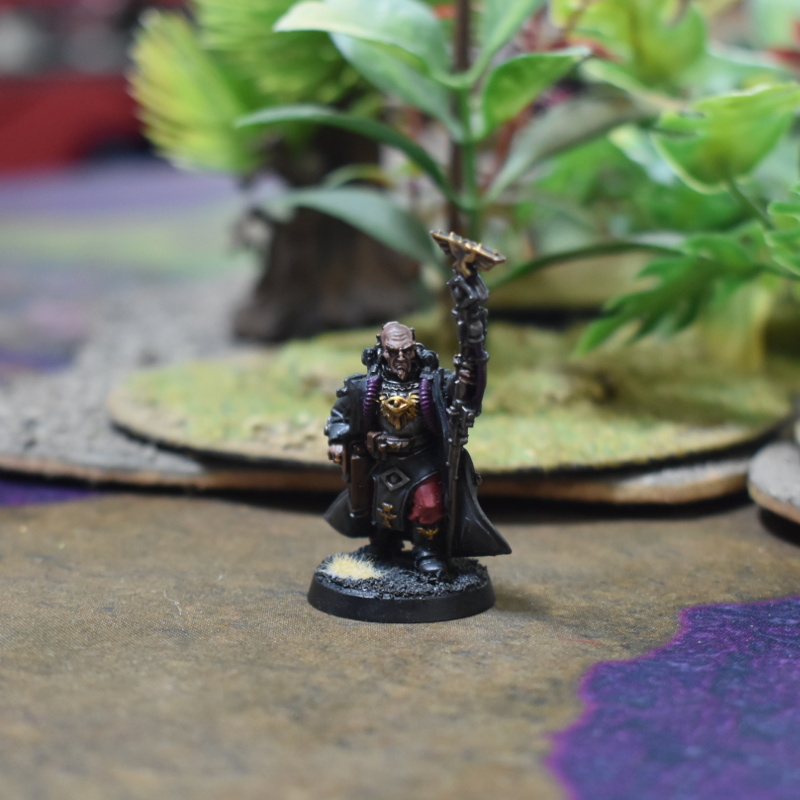
The Psykana discipline has two powers that deal mortal wounds. Unfortunately, like most of the powers from the early days of 8th edition, the powers have a very high variability. Gaze of the Emperor (WC 6) is a line power with a random (2d6″) length; for every model (not unit) that the line passes over a mortal wound is dealt to that model’s unit on a d6 roll of 4+. Psychic Maelstrom (WC 7) has some utility as it has an 18″ range, can target any enemy unit in range, and does not require line of sight. It deals mortal wounds on sequential d6 rolls of 2+, 3+, 4+, 5+ and 6+ but any failed roll ends the sequence.
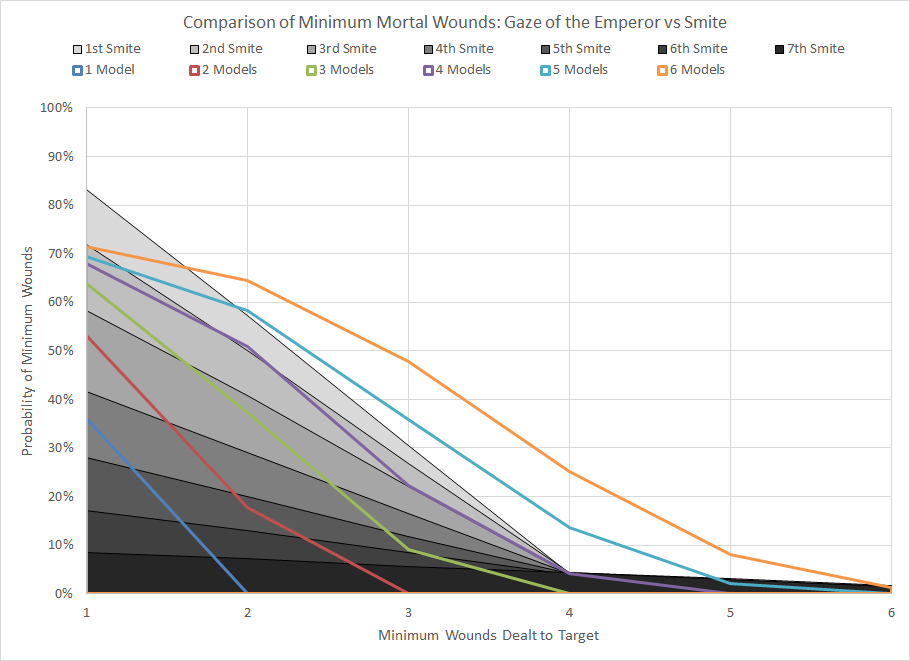
Although it’s nowhere near the level of Trephination, Gaze of the Emperor is still a garbage power that is too situational and ineffective to be worth taking. The Psykana discipline is better-suited for bolstering Astra Militarum models with Psychic Barrier and Nightshroud.
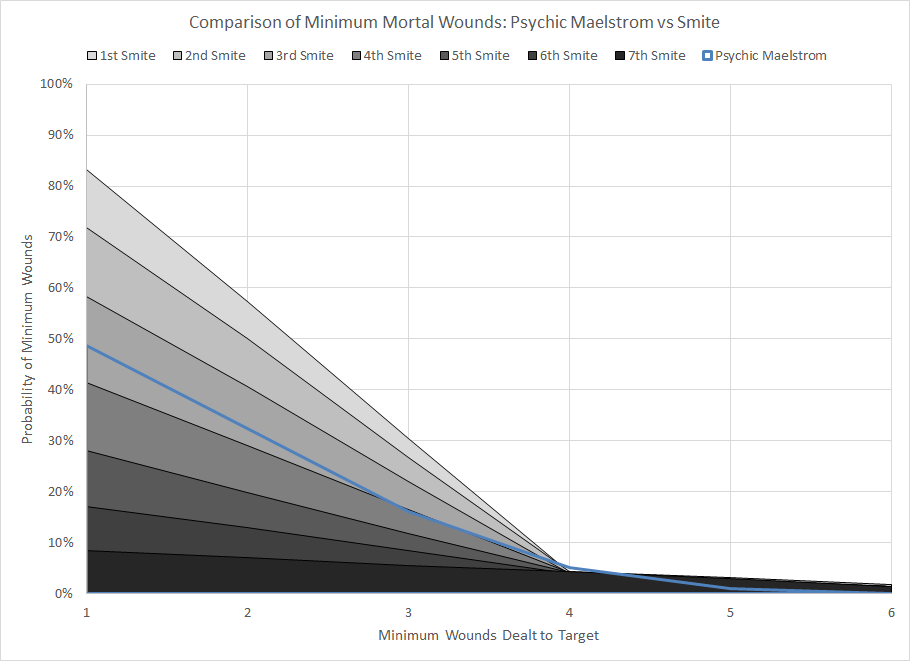
Psychic Maelstrom is slightly better than casting Smite a fourth time, which is not unexpected given that the power can target any enemy model within range. The combination of fairly high warp charge and the possibility of failing the first die roll means that the power will completely fail to do any damage half the time. Leave the offense to ordnance.
Inquisition: Telethesia Discipline
While the Adeptus Astartes are going on their second edition, the poor Inquisition is still relegated to the Index book and three sub-par powers in the Telethesia discipline. None of the powers can deal mortal wounds. From a competitive perspective Inquisitors are rarely seen, and aside from the potential shenanigans of using Dominate (WC 7) to force an enemy to shoot their friends, none of the powers are particularly interesting. Terrify (WC 6) could potentially have some synergy with other powers that target Leadership, but in general those powers have such a high variance that it’s not worth it.
Conclusions

Appropriately used, mortal wounds can be a powerful means of directly damaging vital portions of your opponent’s army. Smite, with its combination of high reliability and low warp charge, is an easy standard by which to compare all other powers. When it comes to Imperial forces the mortal wound powers range from the potentially useful (Machine Flense, Chasm, Wrack and Ruin) to the incomprehensibly terrible (Trephination). Many of the powers are extremely situational and require a combination of specific targets, careful positioning, and in some cases specific Stratagems in order to be effective. In general the more opportunities there are for a power to fail, such as powers which require roll-off, the better off the player is ignoring that power entirely.
In a future article we’ll cover the psychic disciplines from the other factions in a similar fashion. Until then, if you have any questions or comments, feel free to drop a note in the comments below, or email us at contact@goonhammer.com — we’re always looking for new things to analyze in Hammer of Math.


